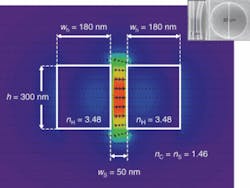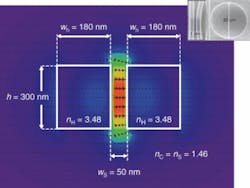Low-index slot serves as waveguide
Most light guides in use today are high-index materials surrounded by low-index materials, and use total internal reflection as the light-guiding mechanism. There is always some loss from the waveguide due to scattering and evanescent coupling. At the Fall Meeting of the Materials Research Society (Boston, MA) in December, researchers at Cornell University (Ithaca, NY) reported guiding light in a low-index material surrounded by high-index materials in a manner that does not depend on reflection by interference.1
Vilson Almeida described how light was captured in a narrow low-index (air-filled) slot between two high-index single-mode waveguides. The electric-field discontinuity at the interfaces keeps the light strongly confined between the high-index materials. "There will always be some loss because of imperfections in manufacturing," explains Professor Michal Lipson, leader of the Cornell group, "but in theory we have a waveguide with zero loss."
Other groups have developed methods that guide light in a low-index material on a high-index-contrast platform, such as the antiresonant reflecting optical-waveguide structure. These methods largely depend on reflection by interference, they tend to be wavelength dependent, and they result in devices with relatively large transverse dimensions. Hollow-core photonic-bandgap fibers and waveguides tend to use the same principle of guiding by interference. In contrast, Lipson's group guides the light using a structure that creates an electric-field discontinuity at the interface between high-index-contrast materials, which is largely wavelength-independent, and can result in small waveguides.
Back to Maxwell's equations
The light was confined in a slot waveguide consisting of two parallel high-index-contrast silica waveguides separated by a 50-nm-wide low-refractive-index slot. The light traveled as a true eigenmode: in other words, explains Lipson, "this mode, in which most of the light is in the low index, is naturally supported by the waveguide, no matter what the length of the waveguide is." Therefore it is fundamentally lossless. Compared to a standard silicon waveguide, in which much of the light is in the cladding rather than the center, a relatively high percentage of the input light (30%) was guided in the low-index region.
Due to the high index contrast, the electric field has a discontinuity at the walls, with much higher amplitude in the slot than that in the high-index part of the structure. Because the dimensions of the slot are comparable to the decay length of the field, the electric-field amplitude remains high over the entire region of the slot (see figure). Therefore, the average electric-field amplitude in the slot becomes much higher—with normalized average intensity of 20 µm-2—than that in the high-index material. This intensity is approximately 20 times higher than can be achieved in SiO2 with conventional rectangular or photonic crystal waveguides. Therefore, these waveguides are much smaller than conventional ones or photonic-crystal waveguides—and because nonlinear effects require high intensities, they could also be useful for nonlinear devices. Because the slot waveguide does not rely on resonance principles, it is largely insensitive to wavelength.
The researchers made waveguides, directional couplers, and resonator devices with the slot geometry, using silicon-on-insulator substrates fabricated with reactive ion etching and electron-beam lithography. Through modeling and experimental results, they found that the degree of light confinement can be tailored by changing the size of the slot cross section. They found that for a silicon/air-slot waveguide, approximately 60% of the optical power can be confined and guided through air for a slot about 100 nm wide.
The TM and TE modes propagate differently—the TE eigenmode is confined to the slot formed by lithographic patterning, whereas creating a slot for the TM mode would require multilayer design. The slot-waveguide scheme retains the small size and small bend radius necessary for highly integrated photonics technology. Potential applications could include use as a host for active materials, sensing, nonlinear applications, modulation and switching, coupling, and near-field optical microscopy.
REFERENCE
- V. A. Almeida et al., MRS Fall Meeting, Boston MA, paper W6.10 (Dec. 1–5, 2003).

